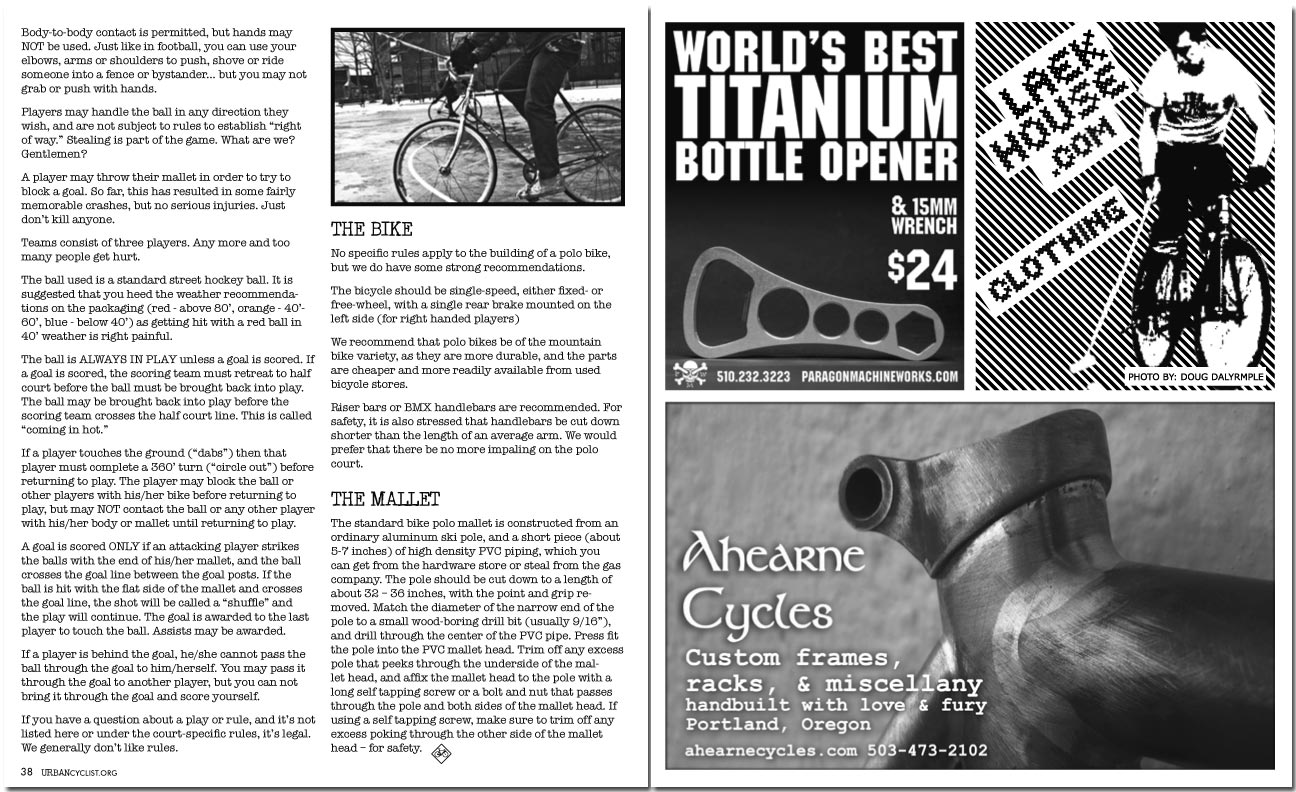
 |
| Polo, Continued
Body-to-body contact is permitted, but hands may NOT be used. Just like in football, you can use your elbows, arms or shoulders to push, shove or ride someone into a fence or bystander... but you may not grab or push with hands. Players may handle the ball in any direction they wish, and are not subject to rules to establish “right of way.” Stealing is part of the game. What are we? Gentlemen? A player may throw their mallet in order to try to block a goal. So far, this has resulted in some fairly memorable crashes, but no serious injuries. Just don’t kill anyone. Teams consist of three players. Any more and too many people get hurt. The ball used is a standard street hockey ball. It is suggested that you heed the weather recommendations on the packaging (red - above 80’, orange - 40’-60’, blue - below 40’) as getting hit with a red ball in 40’ weather is right painful. The ball is ALWAYS IN PLAY unless a goal is scored. If a goal is scored, the scoring team must retreat to half court before the ball must be brought back into play. The ball may be brought back into play before the scoring team crosses the half court line. This is called “coming in hot.” If a player touches the ground (“dabs”) then that player must complete a 360’ turn (“circle out”) before returning to play. The player may block the ball or other players with his/her bike before returning to play, but may NOT contact the ball or any other player with his/her body or mallet until returning to play. A goal is scored ONLY if an attacking player strikes the balls with the end of his/her mallet, and the ball crosses the goal line between the goal posts. If the ball is hit with the flat side of the mallet and crosses the goal line, the shot will be called a “shuffle” and the play will continue. The goal is awarded to the last player to touch the ball. Assists may be awarded. If a player is behind the goal, he/she cannot pass the ball through the goal to him/herself. You may pass it through the goal to another player, but you can not bring it through the goal and score yourself. If you have a question about a play or rule, and it’s not listed here or under the court-specific rules, it’s legal. We generally don’t like rules. THE BIKE No specific rules apply to the building of a polo bike, but we do have some strong recommendations. The bicycle should be single-speed, either fixed- or free-wheel, with a single rear brake mounted on the left side (for right handed players) We recommend that polo bikes be of the mountain bike variety, as they are more durable, and the parts are cheaper and more readily available from used bicycle stores. Riser bars or BMX handlebars are recommended. For safety, it is also stressed that handlebars be cut down shorter than the length of an average arm. We would prefer that there be no more impaling on the polo court. THE MALLET The standard bike polo mallet is constructed from an ordinary aluminum ski pole, and a short piece (about 5-7 inches) of high density PVC piping, which you can get from the hardware store or steal from the gas company. The pole should be cut down to a length of about 32 – 36 inches, with the point and grip removed. Match the diameter of the narrow end of the pole to a small wood-boring drill bit (usually 9/16”), and drill through the center of the PVC pipe. Press fit the pole into the PVC mallet head. Trim off any excess pole that peeks through the underside of the mallet head, and affix the mallet head to the pole with a long self tapping screw or a bolt and nut that passes through the pole and both sides of the mallet head. If using a self tapping screw, make sure to trim off any excess poking through the other side of the mallet head – for safety. |